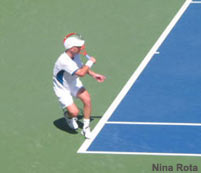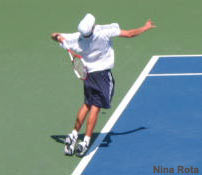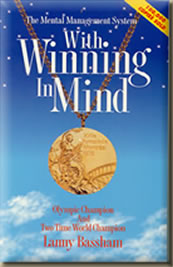Lately my co-writer, Nina Rota, and I have been discussing the career of Amelie Mauresmo, both her playing style and her persona as a female sports personality. She is an interesting player to examine, because she has a ton of talent, and yet we feel she can’t consistently put it out there enough to start winning the big tournaments. Something seems to tie her up. We want to explore that now in this column.
We are both struck by the rather obvious dichotomy in Amelie’s personality: at times she is all strength and power on the court, and then suddenly it all melts away. Her shots become tepid. The creampuff interior takes over the girl with the strong, almost masculine body. It’s as if her body gets handcuffed by its own mind.
I think Amelie is at war with her body. Her mind wants to do one thing with the racquet, her body another. She’s got to decide who’s in charge here. Her body is, has been, developed to be capable of bringing a complete game to the tour. She can really do it all. She is big, she is fast, she has a good strong serve, she can crush you with the forehand, yet her backhand slice shot can be rather delicate and she has a wonderful one-hand topspin backhand as well. One-handers are especially lovely in my book anyway, hers is really nice. She can play net, but she seems happy staying in the backcourt.
So, what’s her problem? Why hasn’t she won the French twice now, and maybe the Aussie at least once? I keep waiting along with the rest of us, I keep hoping things will change for her, that we can rub the magic lamp and out will come finally a wonderfully successful genie of a tennis player, who can show us what it’s like when a really talented female player puts it all together.
Dammit, I want my payoff with this woman. Capriati finally delivered, ditto Davenport. Venus is starting to deliver again. Probably more women players too than I can think of now.
It’s Amelie’s turn. Step up to the plate, as we say in American baseball.
“I need to play with more…aggressivity.” So said Amelie in a TV interview I heard during one of her matches. I remember being charmed by her quaint inventiveness with the English language. And she was certainly defining her difficulty very well. But looking at it now, this comment oddly enough shows her real attitude exactly. She’s speaking with the heart of a Frenchwoman here, swept up as always by the drama of the intellect, the idea of ideas.
She hadn’t a clue what real aggression is. It’s just an idea to her. Instead of wooing me with a lovely turn of phrase, why not come out with, “I’m going to attack her backhand, I’m going to get the returns in play….I’m basically going to rip her a new one with my serve and volley, which I am going to do a lot of in this match.”
Pete Sampras once said, on his upcoming match with Jaime Fillol, that he “was going to go out there and kick his little butt.” I was surprised they let it pass the censor, although Pete did say it with a funny hint of the sarcasm I had heard about but don’t hear often enough.
Now, I pose a question here to the readers: who is more likely to win the match? The guy who kicks butt, or the one who speaks of “aggressivity.”
Who would you put your money on?
That’s the problem with her game. Amelie can’t really go in for the kill. She can’t even say she’d kick a little butt or two. Well, then why are you here? What are you doing on the tennis court?
Peter O’Toole once said that an actor who “can’t go onstage feeling he’s king and fully in charge shouldn’t be out there.”
She lets down in big moments because she is not fully committed to the idea of taking victory yet.
If she’s not careful, Amelie is going to be known as the biggest choker in the game, women’s and men’s tours.
I feel Amelie’s lesbianism may factor into this discussion. In Camille Paglia’s book of essays, Vamps and Tramps, there is a passage discussing Martina Navratilova and her rivalry with Chris Evert. Paglia describes the contradiction between the two, and the reversal of expected roles. Navratilova is the swashbuckling, aggressive dyke tennis player, and Evert is the ice queen, heterosexual groundstroker. Yet Navratilova was the one who broke down in tears if she lost a slam final. Evert was the one who hung tougher emotionally. I recall an early match from her career, when Chris was down match point and 2-5. She pulled herself back and won the match.
My take on Amelie is that, from early childhood, she was perceived as being athletically talented and encouraged to pursue sports. It was ok for her to develop musculature. But the more the muscles developed, perhaps it made it more difficult to reach that female inner part, it somehow got a bit lost in the excitement of a physical life. I imagine the French tolerated her rather masculine appearance. They are more willing to accept male energy when it appears in women, as if often does, than Americans.
Some part of Amelie may want to get off that fast-moving train. Amelie was taught how to be strong and muscular, but not how to deal with the fact she is also a woman. And a lesbian as well. How to incorporate that in such a physical life? It’s difficult, and when the burden is too great, she loses. She lets herself lose it, she chooses to screw things up as it were. There is pressure and more responsibility when you win. Just ask Kuznetsova, who has had a terrible season since winning the U.S. Open last year. This week she lost in the first round of the Open. Amelie views it with trepidation.
She’s got to get over this hurdle. It’s a mental thing. This is my take on it.
If I were coaching Amelie, what would I tell her? This past week I’ve heard Brad Gilbert covering a number of the men’s and women’s matches from the east coast, and I thought he would be a perfect man to ask about Amelie. Lo and behold, he volunteered his own opinion when Amelie played at the Pilot Pen last week.
Brad said he would work on her serve, which he thinks is not nearly as powerful as it could be. He would juice up the first serve, and try to get her to do more with her rather weak second serve. Basically, it sounds like Brad wants to tweak her game a bit, he thinks they are small adjustments but crucial when it comes to deciding who wins a Slam and who doesn’t.
I would take the critique a few steps further. The lack of power Amelie shows in her serving game sometimes is also reflected by her other “loopy” style of hitting the ball. Everything seems to have a ton of topsin on it, including her serve. Now topspin can be a wonderful thing, so they tell me. Having grown up in the era of the serve and volley game, I found the arrival of Mr. Borg both fascinating and rather perplexing. No one really uttered the word “topspin” before he came along. The main reason you want topspin is to give yourself a margin of error. But how much margin does Amelie need before she starts sacrificing power for control?
Amelie needs to reclaim her power. This would be more than just a little “tweaking” of her game. She may need to rework her swing, which is very elongated. I would try to work with her on getting more flatness on her forehand shot. Go for more power in other words. I noticed in her play the last few weeks that, when she encounters a rival equal to her like Henin-Hardenne, she has a tendency to hit topspin forehands which may confound nine out of ten of the other women on tour. But when she hits the other big girls in the draw, that loopiness won’t work. Her shots tend to sit up, and Henin-Hardenne was able to really drive them back for winners.
Some coach needs to come into Amelie’s life who can tell her, day after day, that the shortest distance between two points is a straight, flat line. Draw her a picture if you need to. In an ideal world, she should be coached by someone like Jimmy Connors, who knew all about flat, driven shots and how to crush his opponents. The fact he went out and totally decimated a wonderful player and a gentleman like Ken Rosewall suggests to me he’s the perfect guy for a player like Amelie. He had no qualms at all. Amelie has qualms up her wazoo, I would guess.
She needs to get over that. Get her off the baseline. A little man in a red cape with a triton should run along the baseline and prod her in the butt each time she’s inclined to retreat behind the baseline.
Make her come to net more. She so dominates the lesser players in the early rounds of tournaments, that I am surprised she does not try and work on her game more during those matches. They are learning opportunities. She should practice serving and volleying on them. As a female player, you can still do that in the early rounds. It’s not like the men’s field, which is now solid just about from top to bottom of an average tournament. Any guy can almost beat any guy. You have to play for real, no practicing allowed.
Topspin doesn’t have to be floating loopiness. Look at Nadal’s game, he hits a ton of topspin too, but it has tremendous bite on it. I don’t want to change his game to make him hit more flat drives. I would be terrified if Nadal learns how to hit a flat drive. The ball may end up travelling at the speed of sound. God help us. Ditto Fernando Gonzalez’s forehand. Topspin for sure, but it is the scariest looking shot, as McEnroe said once, in tennis today.
I would work with her on her attitude. Against a match last week with Medina-Garrigues of Spain, commentator Mary Jo Hernandez observed that Amelie never really went for her shots. She kept getting the ball in play, hoping her opponent would miss. Amelie should be imposing her game. Even when she had break points, Amelie was not being aggressive enough.
Just for the hell of it I focused on watching only her legs move. This was against the big newcomer Groenefeld, whom Amelie should have been pushing around from the start. But she wasn’t. Her tendency is to want to hug the baseline. And not even the baseline: often she drifts several feet in back of it. She would advance a step or two as she hits the ball, but then she retreats behind the baseline.
The problem with Amelie is not in her body, it’s in her mind. But how do you change that without leaving the woman a complete basket case? Does her being gay factor in here at all? Does loving women mean you can’t go on there on a court and crush them good?
If I sound exasperated with Amelie Mauresmo, it’s because I am. If she were like Amanda Coetzer in build, small in stature without any “power” shots, I wouldn’t care as much about her game. But she’s 5’9″, strong as a rock, she should really be wailing on the ball, and eager to rush the net every chance she gets.
Everything about this woman’s game says, “I am going to be in your face!” Power everywhere you look.
But the attitude keeps her from achieving that.
Why she hasn’t reconciled this is one of the greatest mysteries in women’s tennis today.
– – – – – –



